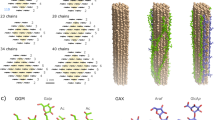Abstract.
The physical characteristics of rubber particles from the four rubber (cis-1,4-polyisoprene) producing species Euphorbia lactiflua Phil., Ficus elastica Roxb., Hevea brasiliensis Müll. Arg., and Parthenium argentatum Gray, were investigated using transmission electron microscopy (TEM) and electron-paramagnetic-resonance (EPR) spin labeling spectroscopy. Transmission electron microscopy showed the rubber particles to be composed of a spherical, homogeneous, core of rubber enclosed by a contiguous, electron-dense, single-track surface layer. The biochemical composition of the surface layer and its single-track TEM suggested that a monolayer biomembrane was the surface structure most compatible with the hydrophobic rubber core. The EPR spectra for a series of positional isomers of doxyl stearic acid, used to label the surface layer of the rubber particles, exhibited flexibility gradients and evidence for lipid-protein interactions for all four rubber particle types that is consistent with a biomembrane-like surface. The EPR spectra confirmed that the surface biomembrane is a monolayer. Thus, rubber particles appear similar to oil bodies in their basic architecture. The EPR spectra also provided information on protein location and degree of biomembrane penetration that correlated with the known properties of the rubber-particle-bound proteins. The monolayer biomembrane serves as an interface between the hydrophobic rubber interior and the aqueous cytosol and prevents aggregation of the particles. An unexpected observation for the probes in pure polyisoprene was evidence of an intrinsic flexibility gradient associated with the stearic acid molecule itself.
Similar content being viewed by others
Author information
Authors and Affiliations
Additional information
Received: 22 May 1999 / Accepted: 21 June 1999
Rights and permissions
About this article
Cite this article
Cornish, K., Wood, D. & Windle, J. Rubber particles from four different species, examined by transmission electron microscopy and electron-paramagnetic-resonance spin labeling, are found to consist of a homogeneous rubber core enclosed by a contiguous, monolayer biomembrane. Planta 210, 85–96 (1999). https://doi.org/10.1007/s004250050657
Issue Date:
DOI: https://doi.org/10.1007/s004250050657




